Newsletters
- Home
- Publications
- Newsletter Archive
- Newsletter
September/October 2019
Inside This Issue:
- Center Board Welcomes Two New Members
- Chairman's Message
- Out-Migration of Pennsylvania's Rural Youth
- Rural Snapshot: Commuting to Work
- Slow Growth in Rural Home Construction
- Just The Facts: Foreign Language Teachers
- Census 2020: How to Respond
Center Board Welcomes Two New Members

Shannon M. Munro and Dr. Joseph T. Nairn
The Center for Rural Pennsylvania Board of Directors welcomes Ms. Shannon M. Munro of Pennsylvania College of Technology and Dr. Joseph T. Nairn of the Northern Pennsylvania Regional College. The two board positions were added with the passage of Act 15 of 2019, which increased the board’s membership from 11 to 13, and specified representation from each college.
Sen. Gene Yaw, Center board chairman, said: “I am pleased to welcome Ms. Munro and Dr. Nairn to the board and look forward to their participation and input in addressing the many issues impacting our state’s rural residents. Their backgrounds in workforce development and education also will serve the board well in continuing to identify issues for the Center’s yearly research grant program.”
Ms. Munro is vice president for Workforce at Pennsylvania College of Technology. She oversees the department responsible for developing and delivering training, consulting, and product development services for companies in multiple business sectors, including industrial, business/leadership, healthcare, plastics, computers, energy and transportation.
She previously served as the executive director of the Central Pennsylvania Workforce Development Corporation. Ms. Munro holds a bachelor’s degree from Bloomsburg University and a master’s degree from Shippensburg University.
Dr. Nairn is the founding president of Northern Pennsylvania Regional College, which was established in 2017. He has nearly 40 years of higher education experience in private and public institutions. He began his career at Thiel College and spent 25 years at Rochester Institute of Technology. In 2008, he joined Finger Lakes Community College in New York, serving as executive assistant to the President and chief advancement officer.
Dr. Nairn has a bachelor’s degree from Thiel College, a master’s degree from the University of Vermont, and a Doctor of Management from the University of Maryland University College.
Chairman's Message
Over the past five years, the Center has been sponsoring public hearings on all aspects of the heroin/opioid epidemic.
Beginning in July 2014 and throughout 2015, the Center held seven statewide hearings to learn about the breadth and depth of the heroin/opioid crisis and its impact on families, communities, treatment facilities, and our criminal justice systems.
From 2016 to 2018, we continued our work gathering information and recommendations on what was becoming the ripple effect of this public health crisis. We heard about the legal and financial challenges now faced by grandparents becoming primary caregivers, and the issues of physical health and behavioral health for those with a substance use disorder.
Through all of the years and the 15 hearings combined, the Center’s Board of Directors remained committed to this issue. Specifically, it wanted to raise awareness and help inform and shape public policy to combat this public health crisis.
The Center’s work continues as we hold our 16th public hearing in Harrisburg this September to hear about the status and impact of the state’s Prescription Drug Monitoring Program, or PDMP. The PDMP was established through Act 191 of 2014 to collect information on all filled prescriptions for controlled substances. The information collected helps health care providers safely prescribe controlled substances and it also helps patients get the treatment they need.
Joining us for the hearing will be two new board members, Ms. Shannon Munro, representing the Pennsylvania College of Technology, and Founding President Dr. Joseph Nairn of the Northern Pennsylvania Regional College.
In addition to planning the public hearing, Center staff is busy reviewing research proposals recently submitted for the 2020 research grant cycle. The board will consider funding recommendations at its December meeting. The researchers who are awarded funding will begin their research in early 2020.
Now that summer is coming to a close, it’s time to enjoy Pennsylvania’s season of fall foliage and festivals. From county fairs to hometown arts events and craft shows, rural Pennsylvania provides an autumn that is sure to please.
Enjoy this time of the year.
Senator Gene Yaw
Out-Migration of Pennsylvania's Rural Youth
The out-migration of young adults in rural Pennsylvania is an ongoing challenge as it affects the future viability of our state’s rural areas and small towns.
According to the latest data from the U.S. Census Bureau, among the more than 590,000 young adults, age 18 to 34, who lived in rural Pennsylvania in 2016, 36,242 moved out of rural Pennsylvania in 2017. The majority of these adults (63 percent) moved to another state and 37 percent moved to urban Pennsylvania.
To learn more about the similarities and differences between rural youth who stay in rural Pennsylvania and those who move out, the Center examined data from the 2017 American Community Survey, Public Use Microdata Sample from the U.S. Census Bureau. Here’s what the analysis uncovered:
- 62 percent of those who moved out of rural Pennsylvania are male and 38 percent are female. Among those who stayed, 52 percent are male and 48 percent are female.
- 12 percent of those who moved out of rural Pennsylvania are non-white, compared to 7 percent who stayed.
- 25 percent of young adults who moved out of rural Pennsylvania are married, compared to 32 percent who stayed in rural Pennsylvania.
- 46 percent of those who moved out of rural Pennsylvania have a bachelor’s degree or higher. Among those who stayed in rural Pennsylvania, 23 percent have a bachelor’s degree or higher.
- 86 percent of those who moved out of rural Pennsylvania are employed compared to 77 percent who stayed.
- 29 percent of young adults who moved out of rural Pennsylvania live alone. Among the young adults who stayed in rural Pennsylvania, 10 percent live alone.
- 24 percent of young adults who left rural Pennsylvania are homeowners; in comparison, 61 percent of young adults who stayed in rural Pennsylvania are homeowners.
- 20 percent of young adults who left rural Pennsylvania have children living in their home. Among those who stayed, 41 percent have children living in their home.
- The median household income for those who left rural Pennsylvania is $55,757 and the median among those who stayed is $64,079.
- 17 percent of young adults who left rural Pennsylvania have incomes below the poverty level. Among those who stayed, 14 percent have incomes below the poverty level.
Bottom line: young adults who leave rural Pennsylvania have higher levels of educational attainment and higher levels of employment. Those who stayed are more likely to be married, have higher incomes, and have higher rates of homeownership.
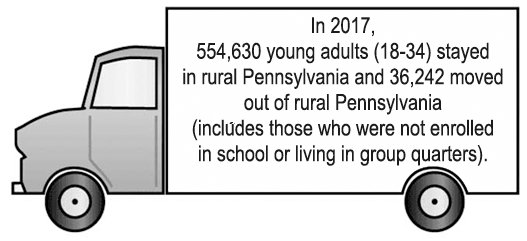
How we analyzed the data
The 2017 American Community Survey, Public Use Microdata Sample questionnaire collects information on individuals who are 1 year old and older, and documents where they lived the year before the survey. The two survey response choices are the same house or a different house. Those who live in a different house are then asked for the mailing address of their prior residence. The addresses are then aggregated to the Public Use Microdata Sample Areas (PUMAs).
For the analysis, the Center recoded the Pennsylvania PUMAs used for migration as rural or urban, and recoded all of the other PUMAs as out-of-state. The Center then recoded the young adult population into one of two categories: those who did not move or moved from one rural PUMA to another, and those who moved from a rural Pennsylvania PUMA to an urban Pennsylvania PUMA and those who moved out-of-state. The Center excluded from the analysis people living in group quarters and those who were enrolled in school or college within the past 3 months.
Rural Snapshot: Commuting to Work
Data sources: 1990 and 2000 Censuses, and 2010 and 2017, 5-year Average, American Community Survey, U.S. Census Bureau.
How Rural Residents Get to Work, 2017
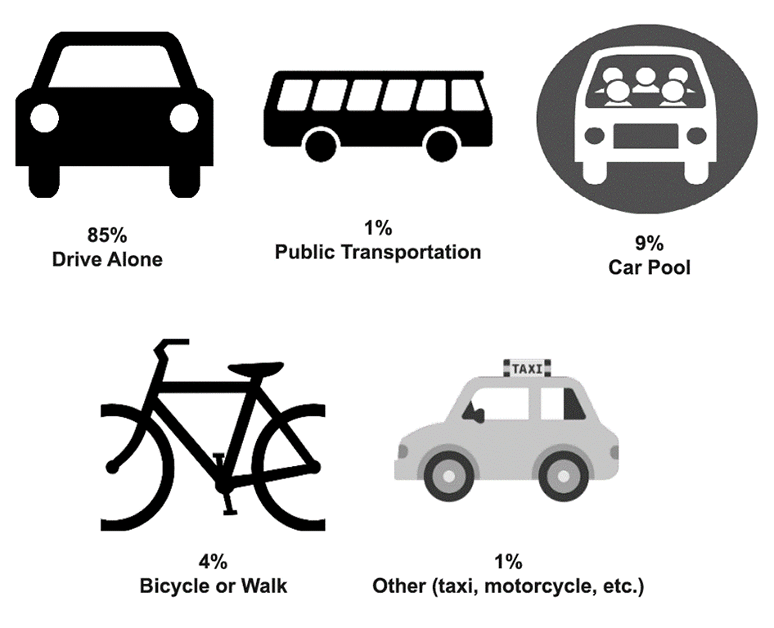
Average Commute Time (in Minutes) by County, 2017
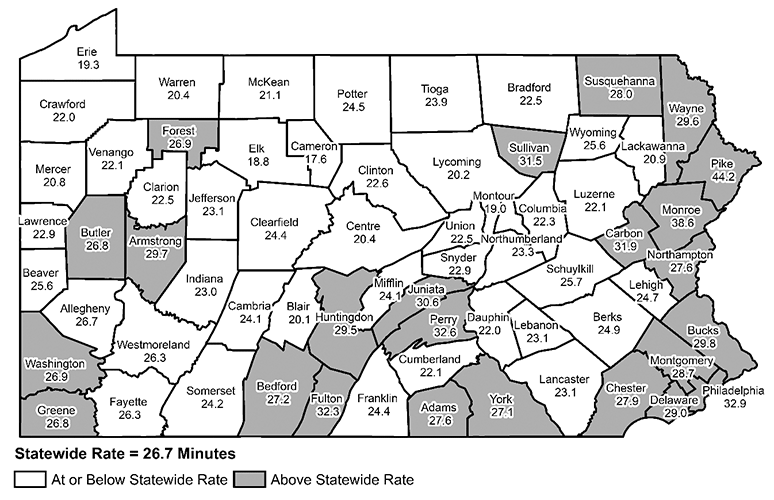
Percent Change in Rural and Urban Commuters Driving Alone and Using Public Transportation, 2010 to 2017
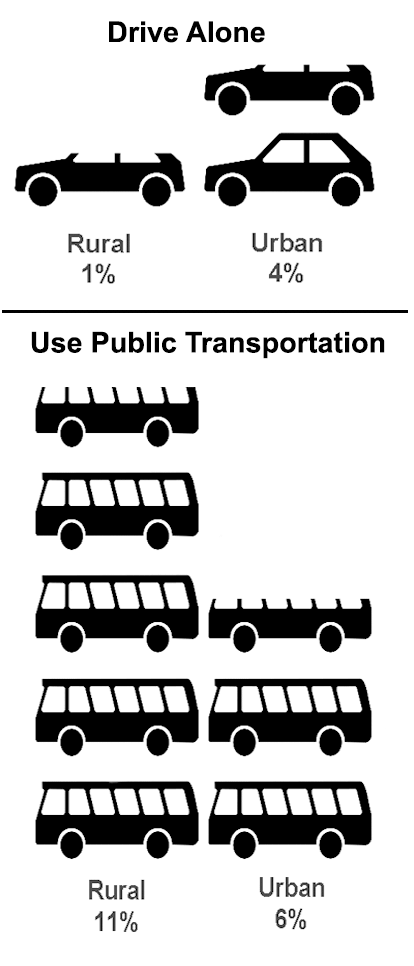
Place of Work for Rural and Urban Workers, 2017
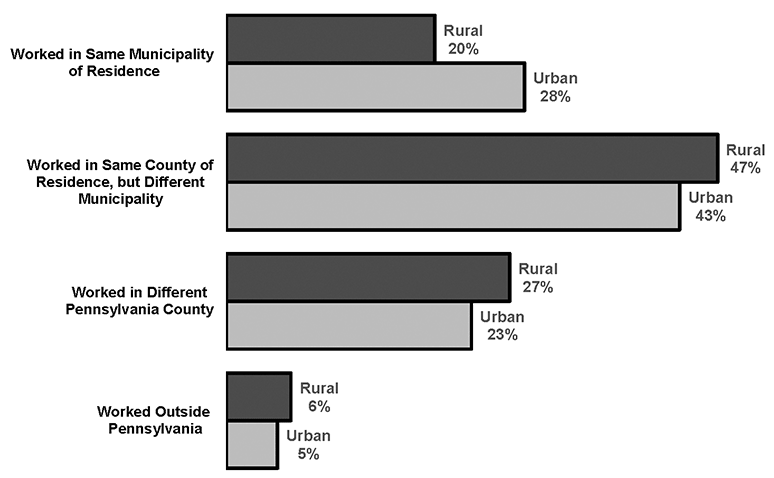
Average Commute Time (in Minutes) for Rural and Urban Workers, 1990 to 2017
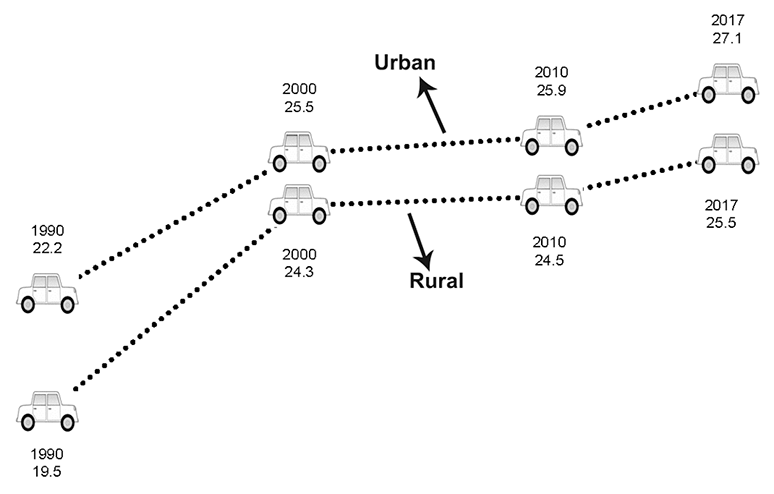
31 percent of rural Pennsylvania commuters and 27 percent of urban Pennsylvania commuters leave home between the hours of 5 am and 7 am.
Median Annual Rural Wage/Salary for Employed Rural Adults (18+) by Commute Time, 2017*
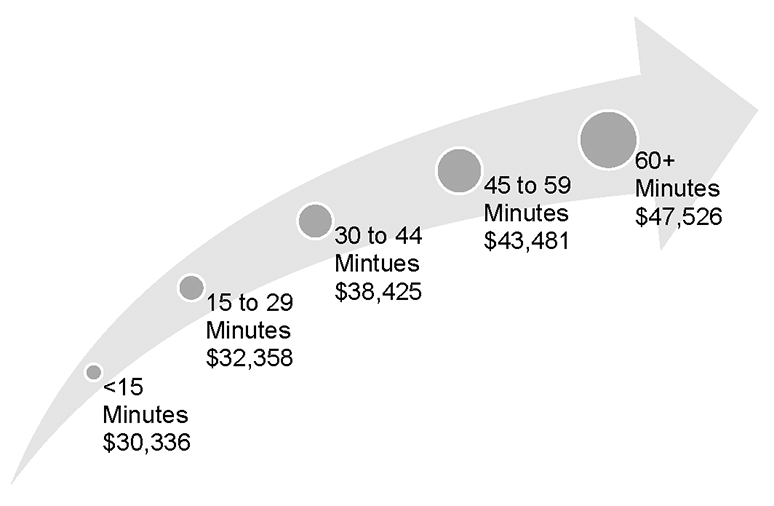
*Data include employed persons 18 years old and older. Data source: 2017 American Community Survey, Public Use Microdata Sample, U.S. Census Bureau.
Slow Growth in Rural Home Construction
Recently released data from the U.S. Census Bureau suggest that the housing construction industry in rural Pennsylvania is growing slowly.
From 2010 to 2018, rural Pennsylvania gained about 36,300 new housing units, or a 2 percent increase. During this same period, urban Pennsylvania gained three times as many new houses (109,500 units or a 3 percent increase).
Across the U.S., there were more than 6.83 million new homes built, or a 5 percent increase, during this same period.
A few demographic and economic factors could explain the slow growth in rural Pennsylvania’s housing construction from 2010 to 2018: rural Pennsylvania’s population decreased 2 percent; the number of people 65 years old and older increased 18 percent; and the number of people in the rural labor force decreased 4 percent.
Not surprisingly, the effect of this slow growth was felt by home builders. From 2010 to 2018, the number of people employed in residential building construction increased only 2 percent, and the number of companies in this business fell by 10 percent. In urban areas, employment in residential building construction increased 15 percent, and the number of companies increased 10 percent.
Perhaps because of the lower demand, the average annual wage of rural home construction workers was much lower than urban construction workers at $38,585 and $53,134, respectively.
Despite the slow growth in new construction, the value of new residential homes in rural Pennsylvania has increased. In 2018, the average value of a new home, as reported on building permits, was $229,890, or an increase of nearly $32,000 from 2010, after adjusting for inflation. In urban Pennsylvania, the average value of a new home in 2018 was $193,200, or nearly $4,000 more than in 2010.
This suggests that some newly constructed homes in rural Pennsylvania may be higher end homes. According to the 2010 and 2017 American Community Survey, 5-year average, from 2010 to 2017, the number of homeowners with homes valued at $500,000 or more increased 22 percent in rural Pennsylvania and 6 percent in urban Pennsylvania.
Change in the Number of Housing Units in Pennsylvania, by County, 2010 to 2018
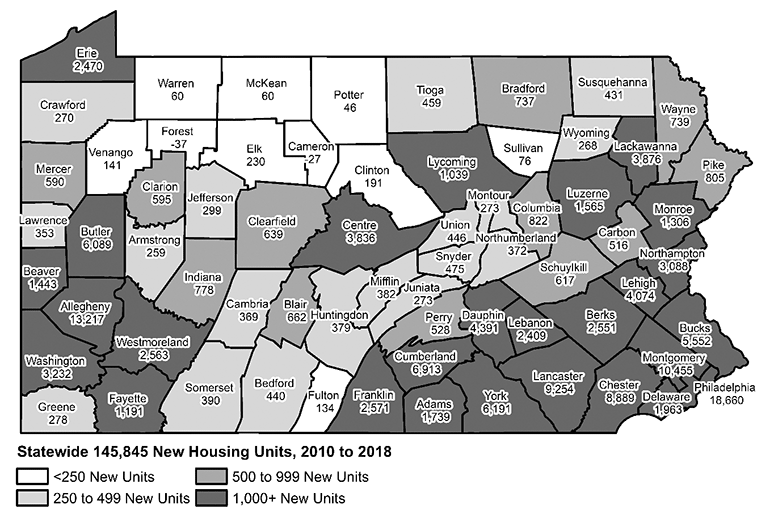
Just The Facts: Foreign Language Teachers
¿Hablas Español? Parlez-vous Français? Sprichst du Deutsch? If you can speak any of these languages, there’s a good chance you have a foreign language teacher to thank.
According to data from the Pennsylvania Department of Education, during the 2017-18 school year, rural school districts had a total of 649 foreign language teachers, or one teacher for every 626 students. In urban districts, there were 2,432 foreign language teachers, or one teacher for every 539 students.
The majority of foreign language teachers in rural Pennsylvania provide instruction in Spanish (68 percent), French (22 percent) and German (12 percent). In addition, 4 percent of these teachers provide instruction in other languages, such as Chinese, Arabic, and Latin. As you can see, the total does not add up to 100 percent because approximately 5 percent of these teachers provide instruction in two or more languages. Language instruction among urban foreign language teachers is similar to that in rural districts.
From the 2010-11 school year to the 2017-18 school year, there was an overall decline in the number of foreign language teachers in both rural and urban school districts. Among the districts that reported data in both school years, rural districts had an 18 percent decline in foreign language teachers and urban districts had a 13 percent decline.
Statewide, the biggest decline was among Russian and Arabic teachers, each with more than a 40 percent decline. French and Germen teachers each declined by 20 percent.
In both rural and urban school districts, more than 80 percent of foreign language teachers are female and they have about 14 years of experience in the classroom. However, foreign language teachers in urban school districts have higher educational attainment levels and higher salaries. In 2017-18, 62 percent of urban foreign language teachers had a master’s degree or higher compared to 55 percent of rural foreign language teachers. That same school year, urban teachers had a median salary of $70,466, nearly $10,000 higher than rural teachers, who had a median salary of $60,557.
Census 2020: How to Respond
By April 2020, households will receive an invitation to participate in the 2020 Census. Households will then have three options to respond: online, by phone, or by mail.
The U.S. Census Bureau will mark Census Day on April 1, 2020, with events across the country. This is a key date for the 2020 count. When completing the census, respondents will note where they are living on April 1. For more information on the 2020 Census, visit https://2020census.gov/.
